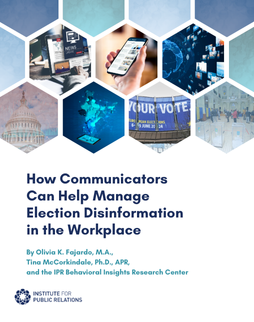
There weren’t many dominant themes during the Institute for Public Relations’ Bridge Conference 2023, which occurred during two temperate days in Washington, D.C., in late March. This was purposeful.
Instead, the agenda provided a wide swath of knowledge, from AI and PR crisis to the importance of communication measurement and behavioral science.
Yet there was some trend spotting, during Day 2, when IPR President & CEO Dr. Tina McCorkindale held a fireside chat with Eleanor Hawkins, editor of the Axios Communicators newsletter.
A former professional communicator, Hawkins’s top trends included PR’s use of AI, the increase in multi-platform tactics and the rise in internal communication, as the nature of work changes post-pandemic. Internal communicators, she said, are emphasizing “employee branding” and experience, creating a visible corporate culture that places a premium on how staff are treated.
As a result, Hawkins noted a rise in the number of corporate retreats and all-staff meetings, where employee concerns are heard. In addition, with employers adopting WFH and hybrid regimes, internal communicators are playing a central role in ensuring companies are intentional in the in-person activities.
As such, Hawkins is optimistic that internal communication will retain the importance it gained during COVID. “There’s tremendous potential…for companies that use communication as a strategic weapon,” she said.
Turning to AI trends, Hawkins acknowledged she uses AI tools when preparing for interviews. “I expect sources I interview do the same,” she said.
In addition, Hawkins mentioned an interesting example of Microsoft using AI in its messaging. Since corporate messages sometimes get diluted after multiple iterations, Microsoft tasks AI with spotting key points. If AI is unable to find them, chances are humans won’t either, Microsoft believes.
Similarly, during a panel about health communication lessons from the pandemic, Mike Kuczkowski, CEO & Founder of Orangefiery, Dr. Cassandra Hayes, Assistant Professor at Stephen F. Austin State University, and Dr. Victoria McDermott, Assistant Professor at University of Alaska Fairbanks, emphasized the importance of easily understood messages.
For instance, “people act on emotion” during a crisis, such as COVID, so facts alone don’t always break through the noise, Dr. Hayes said. On the other hand, facts couched in clearly told stories can raise peoples’ comfort level during crises, she added.
Indeed, panelists agreed certain anti-vaccination stories were well crafted, though sometimes “facts didn’t get in the way,” Dr. Hayes said.
Yet Dr. Hayes decried crafting healthcare narratives that play on emotion only. Instead, communicators should structure stories around problems and solutions.
Another pandemic-related lesson, the panelists agreed, is using visuals for clear communication. Again, the anti-vax community did this well, Dr. McDermott said, noting graphics played on the public’s “uncertainty.”
Part of that uncertainty, Kuczkowski added, was the changing nature of scientific knowledge, especially when dealing with a new virus, as COVID was initially. The public discovered science “isn’t static…it evolves,” he said, which resulted in inconsistent messages over time.
Likewise, the concept of time was critical in the data analytics presentation of Dr. Julie O’Neil, IPR Measurement Commission Director and Associate Dean for Graduate Studies and Administration at Texas Christian University. Dr. O’Neil argued creating a measurement culture requires having useful platforms, proper procedures and inquisitive people. Yet, she insisted time is critical, too. “You can’t crank out” useful insights from data “quickly…it requires time.”
Similarly, inserting behavioral science into your PR strategy means adding time and effort, panelists said during a session about behavioral science. Yet understanding what motivates human behavior gives PR pros an edge and it “makes money,” said Dave Scholz, IPR Behavioral Insights Research Center Director and Chief Strategy Officer at Leger. And it doesn’t necessarily cost money. “There’s a lot of free research” available from academia. “Use it,” he said.
Panelist Stacey Smith, senior counsel and partner, Jackson Jackson & Wagner, offered a novel approach to teaching PR students about behavioral science. “Have them take a theater class,” she said. “It will teach them about why a character does something…they’ll learn and it will be fun.”
For PR pros wanting to create a behavioral science culture, she urged “focusing on one behavior you’re trying to change,” she said. “Then look at the barriers to change” and research what data says can help effect change.

Seth Arenstein is a freelance writer and former editor of PRNEWS.



